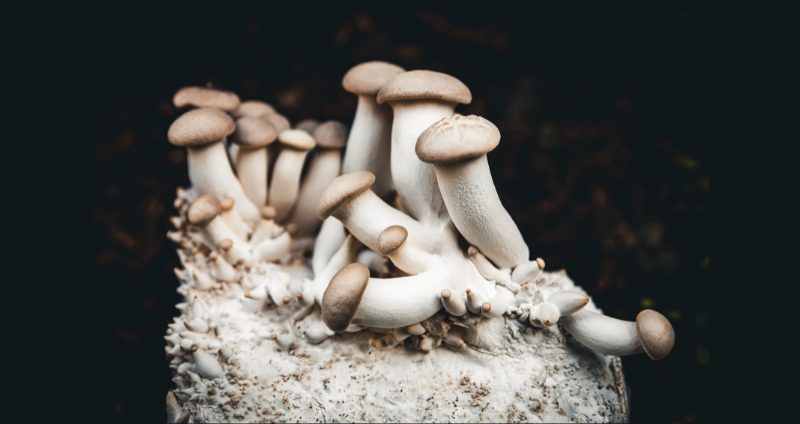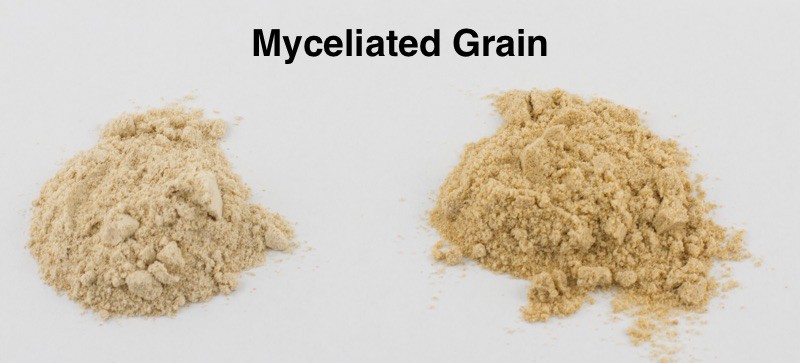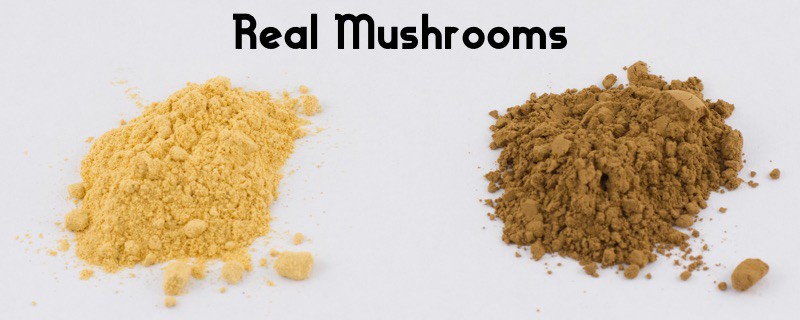Menu



There are many mushroom supplements in the marketplace today that are marketed as extracted from a mushroom (fruit body) but do not contain any mushrooms (fruiting bodies). These are products made from what is called myceliated grain.
This very important distinction is not easy to identify and the consumer is left believing they have purchased mushrooms when in fact that's very far from the truth. This is because not a lot of consumers are aware of the mushroom life cycle and the mushroom growing process.
This is even true for many influencers and health practitioners who often cite research based on mushrooms and then recommend a product that contains no mushrooms.
I've reviewed many mushroom and myceliated oats-derived products and even I still get stumped when trying to determine what the product is actually made from because the marketing materials are so confusing. Sometimes the company itself doesn't know what they are selling because they're buying from a 3rd party ingredient supplier who is buying from the actual source. It's like a bad game of Telephone.
Below are some tips you can use to determine if a product is myceliated oats.
Myceliated oats, or known as myceliated grain or mycelium biomass, are produced by growing mycelium, the mushroom root system, on a grain substrate. This technique was developed back in the 1930s to produce seed for growing fresh mushroom mycelium. Mushrooms growers call this seed grain spawn.
The process involves putting cooked grain into a plastic bag and sterilizing it in a giant pressure cooker called an autoclave. Then the sterile grain is inoculated [injected] with mycelium of the desired fungal species like reishi or lions mane or cordyceps.
Inside the plastic bag, the mycelium will then grow out on the grain and create an inseparable white mass. This mass is very similar to the Asian, fermented food product tempeh. Once the mycelium growth is complete, the mycelium and the grain are harvested together, dried and powdered.
This myceliated grain is now sold as a “mushroom” ingredient even though it contains no mushrooms. The grain component, which dilutes the amount of mycelium present, is often not disclosed.
In a video where a local TV news organization toured a major producer of myceliated grain, you can see very clearly the exact process of how myceliated grain is produced.
It is an excellent video to get a full understanding of the mushroom life cycle and how myceliated grains are processed.
When watching the video, count the number of times you hear the word mushroom and the number of times you actually see any mushrooms (fruiting bodies).
For one, much of what you're paying for is grain or just mycelial biomass.
In fact, a patent filed by Paul Stamets (see example 9) estimated that myceliated grain contains 60-70% grain.
More grain equates to less mycelium, which equates to less active compounds. This was confirmed in the Nammex White Paper [1] and the McCleary & Draga research [2]. The active compounds, like beta-glucans, are where most of the benefits are derived.
Secondly, the majority of the research literature is based on the mushroom (fruiting body). While there is a large body of research on mycelium, almost all of this is based on pure mycelium made through liquid fermentation. Liquid fermentation grows the mycelium biomass in a liquid medium instead of a grain substrate. The liquid can then be drained off at the end of the growing process, leaving just pure mycelium.
If you are someone who is trying to avoid grains (allergies, paleo, keto, etc.), you may be inadvertently consuming grains without knowing it.
Myceliated grain, sold as mushroom supplements, is almost entirely grown in the US. This is because it is too expensive to grow mushrooms for supplements in North America. Products claiming “US Grown” are almost always mycelium products and not mushrooms.
Pure mushroom extracts generally come from China. As of 2013, China has grown over 85% of the world's mushrooms [5], and this has been steadily climbing.
Mushroom extracts vary in color depending on the color of the mushroom whereas myceliated grain almost always looks the same. This is because the mycelium is a uniform color and the grain is also a uniform color.
Typically, myceliated grain is light in color, similar to the color of the grain on which it grows.
Can you tell which one is Cordyceps and which one is Reishi?

 Note the distinct differences in color. Guess which one is cordyceps and which one is reishi?
Note the distinct differences in color. Guess which one is cordyceps and which one is reishi?
If you ordered mushroom supplements in powder form like reishi or chaga and it's a light color, start asking questions.
If it is made from mushrooms, it should taste like mushrooms.
For mushrooms like reishi, it should taste bitter since one of the main active compounds in reishi are bitter triterpenes. Bitterness is a good quality indicator for a high quality reishi extract.
Is your reishi bitter? Ours is.
In contrast, myceliated grain tastes very bland and is often marketed as having “no mushroom flavor.” When you realize that there is a large amount of grain in the product, your mind will start to think it tastes like grain.
While this is not an absolute indicator since many mushroom extracts are still measured for polysaccharides, some myceliated grain products are also tested for this. They often show very high polysaccharide counts but as we've seen, polysaccharides are a poor measure of quality as starch is a polysaccharide so any residual grain will increase the total polysaccharides giving you a false sense of quality.
If you look at [1] and [2], you will see high total polysaccharides for myceliated grain products (alpha-glucans + beta-glucans), but the majority of it comes from alpha-glucans which are primarily starches (not what you want).
Although it’s a requirement by the FDA to properly label whether a product is mushroom or mycelium, this is often overlooked by the brand. [3] Either they themselves are unaware that their ingredient is myceliated grain and they think it is mushroom or they are trying to mislead you.
The American Herbal Products Association has also released a labeling guide stating that mycelium or mushroom should be properly identified. [4]
Common terms you can use to identify myceliated grain:
Make sure to read the marketing materials, ingredient info and supplements panel very carefully.
If a product is grown in the US, it is fairly certain that it is myceliated grain and not mushroom. There are some exceptions to this for small-scale producers.
Myceliated grain, also known as myceliated oats or mycelial biomass, has been shown to be primarily grain and contains very few of the active compounds that make mushrooms beneficial. While there is mycelium research, it is almost always based on pure mycelium made through liquid fermentation which does not contain any grain in the final ingredient.
We believe it is important for consumers to be aware of what they are consuming and know about the different processes used to make mushroom and mycelium products.
At Real Mushrooms, we are committed to providing high-quality mushroom products that are:
Every mushroom supplement in our shop, whether it’s in powder or capsule form, is third-party tested to ensure you’re getting the health benefits of our selection of functional mushrooms.
Please leave any questions or comments below!
 .
.Disclaimer: The information or products mentioned in this article are provided as information resources only, and are not to be used or relied on to diagnose, treat, cure, or prevent any disease. This information does not create any patient-doctor relationship, and should not be used as a substitute for professional diagnosis and treatment. The information is intended for health care professionals only. The statements made in this article have not been evaluated by the Food and Drug Administration. Any products mentioned are not intended to diagnose, treat, cure, or prevent any disease. The information in this article is intended for educational purposes. The information is not intended to replace medical advice offered by licensed medical physicians. Please consult your doctor or health practitioner for any medical advice.